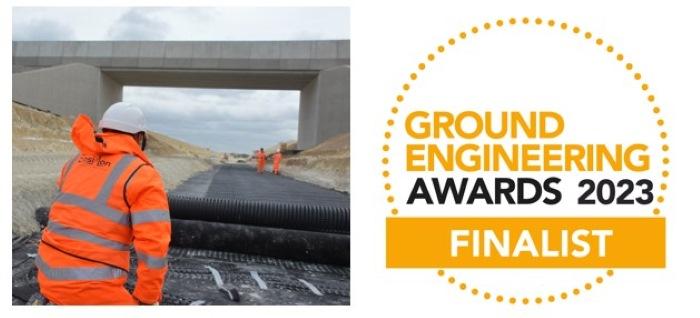
Submitted by Dr Fiorella Del... on Thu, 13/04/2023 - 16:25
The project ‘Real-time monitoring of sub-surface ground movement using a distributed fibre optic-instrumented geogrid’ has been shortlisted for the Ground Engineering Awards 2023 for Technical Excellence. This is a significant achievement for the project partners CSIC, Epsimon, HUESKER, Jacobs, Align JV and HS2 (High Speed Two) Ltd as it recognises the several years of collaboration aimed at developing a robust ground monitoring technique to mitigate against the risks posed by sub-surface voids under built infrastructure.
A novel and hi-tech system for monitoring of ground movement, called Sensorgrid, consisting of an innovative fibre optic (FO) instrumented geogrid, was implemented at Tilehouse Lane Cutting (TLC) in May 2022. TLC is a 710m-long and up to 13m-deep excavation in chalk along the HS2 route, connecting the Colne Valley Viaduct with the south portal of the Chiltern Tunnels, constructed by Align JV. Excavation at TLC revealed dissolution features which required design measures, consisting of a geogrid reinforced mattress at the base of the cutting, to mitigate for potential voids beneath the track slab. In addition, it was also deemed important to detect potential gradual movement beneath the mattress at an early stage, both during construction, when TLC is being used as a haul road, and during the operation of HS2.
Sensorgrid is the result of a close collaboration between CSIC, Epsimon and Huesker, which worked together to design, test, install and operate the monitoring system. It was first trialled at small scale to assess its measurement sensitivity and robustness. A Sensorgrid with sensing cables spaced every 0.5m was then installed over an area of 1000m2 at TLC, providing 10,000 sensing points and enabling the localisation of movement with a spatial resolution of 0.25m. Laboratory and field-testing results demonstrated that Sensorgrid enables the detection and localisation of millimetric movements due to subsidence or heave, by measuring the resulting changes in the optical properties of the integrated FO cables. The data are processed and displayed in real time on an online dashboard that was developed by Epsimon, allowing the project team to observe any movement that could occur below the current construction haul road at TLC, and on which the HS2 mainline will ultimately be constructed.
The Sensorgrid automated monitoring system could significantly reduce the cost of ground improvement works and their associated carbon footprint, while at the same time improve the operational safety of assets built over uncertain ground conditions. The knowledge gained from the successful deployment at TLC has led to Sensorgrid being developed into a commercial offering that is expected to benefit the delivery and operation of new large-scale infrastructure projects, as well as the operation and maintenance of existing higher-risk assets where the FO-instrumented geogrid can be retrofitted.
The GE Ground Engineering Awards winners will be announced on 12th July 2023.
